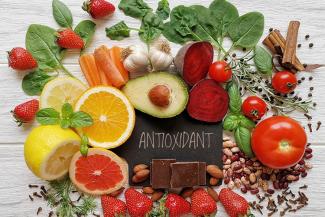Antioxidants: what you really need to know

We can’t hope to build a truly healthy body without the foundations of good nutrition. By definition, health “is a state of complete physical, mental and social well-being and not merely the absence of disease or infirmity” (World health Organization).
When we look at a healthy, balanced diet, the main components (also known as the foundation) are plenty of fresh fruits and vegetables; wholegrains; lean proteins; legumes; fats; and dairy. On top of the foundation, we can add extras to help us optimize our health. That’s the role antioxidants have.
Back in 1990’s, antioxidants became very popular due to the correlation between free radical damage and the development of chronic conditions such as vision loss and cancer. Antioxidants are substances that protect cells from damage caused by free radicals. Free radicals are substances that attack healthy cells. They are produced through normal body functions, including food consumption, breathing, exercise, and lifestyle choices. Free radicals damage cell components such as DNA, proteins, and the cell membrane. Free radicals may be increased through toxins found in cigarette smoke, metals, and high-oxygen atmospheres.
Therefore, antioxidants are an important part of a healthy diet and lifestyle.
Many people already consume naturally occurring antioxidants in foods such as vitamin A, C and E, beta-carotene, and lycopene. If you’re not doing so already, aim for fruits and vegetables that represent all the colors of the rainbow. In general, the more vibrant the color, the more antioxidants it contains.
You might be wondering where you can find these micronutrients and what they do.
Vitamin A is involved in immune function, cellular communication, vision, growth and development, and male and female reproduction. It can be found in dairy products, eggs, fish, and organ meats.
Vitamin C has been shown to boost immunity, help in iron absorption, and prevent against chronic diseases. Look for vitamin C in green vegetables, tomatoes, and citrus fruits like oranges and grapefruits.
Vitamin E may help prevent heart disease, inflammation, and may also promote eye health. Vitamin E is found in whole grains, vegetable oils (olive, sunflower, canola), nuts, and leafy green vegetables.
Beta-carotene is the red-orange pigment found in fruits and veggies which may help slow cognitive decline and protect against heart disease. Carrots are especially high in beta-carotene, as well as other fruits, grains, squash, spinach, and other green vegetables.
Lycopene is a phytochemical mainly found in tomato and tomato-based products.
In conclusion, antioxidants are important for preventing damage to your cells that can accumulate over time and increase your risk for disease. To reduce this, focus on getting these nutrients from a variety of whole food sources such as fruits and vegetables in every color of the rainbow, as well as a variety of whole grains and nuts. Look for fresh seasonal produce and add in antioxidant-rich frozen fruits and vegetables to get you through the winter months.
